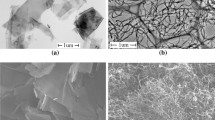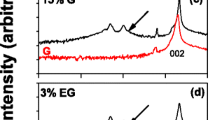Abstract
Three different types of carbon materials [carbon nanotubes (CNTs), carbon black (CB), and carbon fibers (CFs)] were incorporated into polyvinylidene fluoride (PVDF) as single fillers or hybrid fillers (CNT/CB and CNT/CF) via solution blending. The physical properties of the hybrid filler systems such as the electrical, thermal, morphological, and rheological properties were compared to those of the single filler systems. Images of the PVDF composites containing hybrid fillers obtained by a field-emission scanning electron microscope showed that CB appeared to be embedded between highly entangled nanotubes, promoting their debundling in the PVDF matrix. The hybrid filler systems of CB and CF with 0.5 wt% nanotubes were electrically conductive from the corresponding content of 1 wt%, showing maximum values from 5 wt% CB and 10 wt% CF. In the hybrid filler systems, the extent of the increase in crystallization temperature (Tc) in the presence of CB or CF was more prominent at a lower CNT content of 0.5 wt%. In the hybrid systems of CB with 0.5 wt% nanotubes, the melting peak for the β phase was generated from 1 wt% CB and its intensity increased with CB content. On the contrary, the hybrid filler systems of CF with nanotubes did not provide a new peak. Regarding the rheological properties, the complex viscosity (η*) of PVDF/CNT0.5/CB increased with CB content, a pattern similar to that of the single filler system of CB. On the contrary, the presence of CF with 0.5 wt% nanotubes slightly increased η* with CF content, while that with 1 wt% nanotubes notably increased η*, exhibiting a sharp increase at 10 wt%.















Similar content being viewed by others
Data availability
The data that support the findings of this study are available from the corresponding author upon reasonable request.
References
Furukawa T (1989) Piezoelectricity and pyroelectricity in polymers. IEEE Trans Electr Insul 24:375–394
Nagai M, Nakamura K, Uehara H, Kanamoto T, Takahashi Y, Furukawa T (1999) Enhanced electrical properties of highly oriented poly(vinylidene fluoride) films prepared by solid-state coextrusion. J Polym Sci Part B 37:2549–2556
Koga K, Ohigashi H (1986) Piezoelectricity and related properties of vinylidene fluoride and trifluoroethylene copolymers. J Appl Phys 59:2142–2150
Chen QX, Payne PA (1995) Industrial applications of piezoelectric polymer transducers. Meas Sci Technol 6:249–267
Mishra S, Kumaran KT, Sivakumaran R, Pandian SP, Kundu S (2016) Synthesis of PVDF, CNT and their functionalized composites for studying their electrical properties to analyze their applicability in actuation and sensing. Colloids Surf A 509:684–696
Xu L, Du K, Liu Y, Xie K, Tang H, Zhang C (2022) The fabrication and properties of flexible sensors based on polyvinylidene fluoride fiber. Text Res J 92:3443–3450
Takahashi Y (1990) Conformationally incommensurate form of poly(vinylidene fluoride) induced by electric field. J Appl Phys 67:4060–4063
Bae SJ, Kim IJ, Lee JY (2020) Manufacturing and characterization of PVDF/TiO2 composite nano web with improved β-phase. Text Color Finish 32:167–175
Hong HS, Kim SS (2020) Effect of microwave irradiation on conformation of crystalline of PVDF nano-composite film in the solvent evaporation process. Compos Res 33:19–24
Sadeghi F, Ajji A (2009) Study of crystal structure of (polyvinylidene fluoride/clay) nanocomposite films: Effect of process conditions and clay type. Polym Eng Sci 49:200–207
Pramoda KP, Mohamed A, Phang IY, Liu T (2005) Crystal transformation and thermomechanical properties of poly (vinylidene fluoride)/clay nanocomposites. Polym Int 54:226–232
Chen X, Tougne C, Jiang T, Espindola-Rodriguez M, Zhao Q, Jia Q, Mendil-Jakani H, Jiang J, Zhang W (2022) High oriented PVDF molecular chains for enhanced material performance. Polymer 261:125366
Prasad KE, Das B, Maitra U, Ramamurty U, Rao CNR (2009) Extraordinary synergy in the mechanical properties of polymer matrix composites reinforced with 2 nanocarbons. PNAS 106:13186–13189
Yu R, Liu J, Gao D, Wang Y, Wen X, Tang T (2020) Striking effect of nanosized carbon black modified by grafting sodium sulfonate on improving the flame retardancy of polycarbonate. Compos Commun 20:100359
Namasivayam M, Andersson MR, Shapter J (2019) Role of molecular weight in polymer wrapping and dispersion of MWNT in a PVDF Matrix. Polymers 11:162–173
Jia LC, Yan DX, Cui CH, Ji X, Li ZM (2016) A unique double percolated polymer composite for highly efficient elctromagnetic interference shielding. Macromol Mater Eng 301:1232–1241
Chae DW, Hawkins SC, Huynh C (2018) Preparation and properties of PVA composites containing homogeneously dispersed MWNTs. Text Sci Eng 55:71–77
Kasgoz A, Akın D, Ayten Aİ, Durmus (2014) A Effect of different types of carbon fillers on mechanical and rheological properties of cyclic olefin copolymer (COC) composites. Compos Part B 66:126–135
Sumfleth J, Buschhorn ST, Schulte K (2011) Comparison of rheological and electrical percolation phenomena in carbon black and carbon nanotube filled epoxy polymers. J Mater Sci 46:659–669
Zhang Q, Wang J, Zhang BY, Guo BH, Yu J, Guo ZX (2019) Improved electrical conductivity of polymer/carbon black composites by simultaneous dispersion and interaction-induced network assembly. Compos Sci Technol 179:106–114
Das NC, Chaki TK, Khastgir D, Chakraborty A (2001) Electromagnetic interference shielding effectiveness of ethylene vinyl acetate based conductive composite containing carbon fillers. Appl Polym 80:1601–1608
Dong W, Liu HC, Park SJ, Jin FL (2014) Fracture toughness improvement of epoxy resins with short carbon fibers. J Ind Eng Chem 20:1220–1222
Caradonna A, Badini C, Padovano E, Pietroluongo M (2019) Electrical and thermal conductivity of epoxy-carbon filler composites processed by calendaring. Materials 12:1522–1538
Shen L, Wang FQ, Yang H, Meng QR (2011) The combined effects of carbon black and carbon fiber on the electrical properties of composites based on polyethylene or polyethylene-polypropylene blend. Polym Test 30:442–448
Sumfleth J, Adroher XC, Schulte K (2009) Synergistic effects in network formation and electrical properties of hybrid epoxy nanocomposites containing multi-wall carbon nanotubes and carbon black. J Mater Sci 44:3241–3247
Huang K, Ning H, Hu N (2019) Synergistic effect of CB and MWCNT on the strain-induced DC and AC electrical properties of PVDF-HFP composites. Carbon 144:509–518
Li L, Zhang M, Ruan W (2015) Studies on synergistic effect of CNT and CB nanoparticles on PVDF. Polym Compos 36:2248–2254
Sl S, Arjmand M, Navas IO, Yazdi AZ, Sundararaj U (2017) Effect of nanofiller geometry on network formation in polymeric nanocomposites comparison of rheological and electrical properties of multiwalled carbon nanotube and graphene nanoribbon. Macromolecules 50:3954–3967
Hu N, Masuda Z, Yan C, Yamamoto G, Fukunaga H, Hashida T (2008) The electrical properties of polymer nanocomposites with carbon nanotube fillers. Nanotechnology 19:215701
Li C, Thostenson ET, Chou TW (2007) Dominant role of tunneling resistance in the electrical conductivity of carbon nanotube–based composites. Appl Phys Lett 91:223114
Ma PC, Liu MY, Zhang H, Wang SQ, Wang R, Wang K, Wong YK, Tang BZ, Hong SH, Paik KW, Kim JK (2009) Enhanced electrical conductivity of nanocomposites containing hybrid fillers of carbon nanotubes and carbon black. ACS Appl Mater Interfaces 1:1090–1096
Chae DW, Hong SM (2011) Rheology, crystallization behavior under shear, and resultant morphology of PVDF/multiwalled carbon nanotube composites. Macromol Res 19:326–331
Chae DW, Hong SM (2010) Dynamic crystallization behavior, morphology, and physical properties of highly concentrated poly(vinylidene fluoride)/silver nanocomposites. J Polym Sci Part B 48:2379–2385
Kim JH, Lee S, Kim BC, Shin BS, Jeon JY, Chae DW (2016) Effect of VA and MWNT contents on the rheological and physical properties of EVA. Korea-Aust Rheol J 28:41–49
Acknowledgements
This research was supported by Basic Science Research Program through the National Research Foundation of Korea (NRF) funded by the Ministry of Education (NRF-2017R1D1A1B03035939).
Author information
Authors and Affiliations
Corresponding author
Ethics declarations
Conflict of interest
The authors declare no conflicts of interest.
Additional information
Publisher's Note
Springer Nature remains neutral with regard to jurisdictional claims in published maps and institutional affiliations.
Rights and permissions
Springer Nature or its licensor (e.g. a society or other partner) holds exclusive rights to this article under a publishing agreement with the author(s) or other rightsholder(s); author self-archiving of the accepted manuscript version of this article is solely governed by the terms of such publishing agreement and applicable law.
About this article
Cite this article
Kim, W., Oh, Y., Jeon, JY. et al. Combined effect of hybrid carbon fillers on the physical and rheological properties of polyvinylidene fluoride composites. Korea-Aust. Rheol. J. 35, 137–155 (2023). https://doi.org/10.1007/s13367-023-00062-1
Received:
Revised:
Accepted:
Published:
Issue Date:
DOI: https://doi.org/10.1007/s13367-023-00062-1




